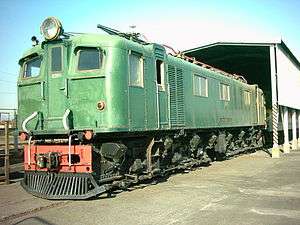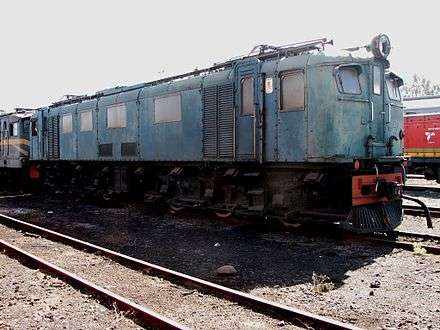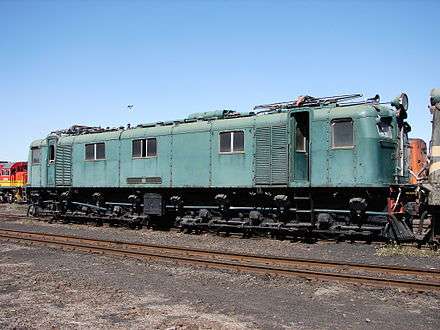South African Class 3E
The South African Railways Class 3E of 1947 was an electric locomotive.
| South African Class 3E | |||||||||||||||||||||||||||||||||||||||||||||||||||||||||
|---|---|---|---|---|---|---|---|---|---|---|---|---|---|---|---|---|---|---|---|---|---|---|---|---|---|---|---|---|---|---|---|---|---|---|---|---|---|---|---|---|---|---|---|---|---|---|---|---|---|---|---|---|---|---|---|---|---|
 No. E201 at Bellville Loco, Cape Town, 29 April 2004 | |||||||||||||||||||||||||||||||||||||||||||||||||||||||||
| |||||||||||||||||||||||||||||||||||||||||||||||||||||||||
| |||||||||||||||||||||||||||||||||||||||||||||||||||||||||
| |||||||||||||||||||||||||||||||||||||||||||||||||||||||||
| |||||||||||||||||||||||||||||||||||||||||||||||||||||||||
In 1947 and 1948, the South African Railways placed twenty-eight Class 3E electric locomotives with a Co+Co wheel arrangement in mainline service.[1]
Manufacturer
The South African Railways (SAR) placed orders for the design and construction of the 3 kV DC Class 3E electric locomotive with Metropolitan-Vickers (Metrovick) in 1944. Although the locomotive was designed by Metrovick who also supplied the electrical equipment, its construction was subcontracted to Robert Stephenson and Hawthorns. Twenty-eight locomotives were delivered and placed in service in 1947 and 1948, numbered in the range from E191 to E218.[1][2]
Characteristics
These dual cab locomotives have three windows between the side doors on one side and four on the opposite side. When the locomotive is observed from the side with three windows, its no. 1 end will be to the viewer’s left. As on the later Class 4E, the locomotive had side doors on both sides behind each cab.[3]
Like the Classes 1E, 2E and 4E, the Class 3E had bogie-mounted draft gear, therefore no train forces were transmitted to the locomotive body. It had a Co+Co wheel arrangement with an articulated inter-bogie linkage.[3]
For the passenger role, provision was made for both electric and steam heating of passenger coaches, although the electric heating feature was never used on mainline passenger trains. The Class 3E had an on-board steam-heating boiler for train heating and were the only electric units to have this feature. Subsequent electric locomotive models like the Classes 4E, 5E and 6E used separate steam wagons on passenger service during the winter months.[1][4]

Unlike Cape Town's and Durban's suburban trainsets, those working around Johannesburg had jumper connections on the roof above the end connecting doors. The Class 3Es were also equipped with these connections, immediately to the right hand side of each headlight. During a shortage of suburban motor coaches c. 1948-1949, Class 3Es were used to haul suburban sets on the Witwatersrand and it is likely that the electric heating system was used during those winters. In the picture alongside showing rarely seen snow on the ground along the Johannesburg-Pretoria line on the Transvaal Highveld, the roof jumper connections between the suburban coaches and next to the unit's headlight are visible.
The locomotives entered service in an all-green livery which was changed to green with yellow whiskers in the 1950s and to gulf red with yellow whiskers in the 1960s.[5]
Service
The Class 3E was the first six-axle electric locomotive in SAR service and was geared for a maximum safe speed of 105 kilometres per hour (65 miles per hour). It was designed for both goods and passenger working on the Western Transvaal System, where higher speeds were possible on track with less severe curvature than on the lower Natal mainline. Some did enter service in Natal in 1948, but since they were not really suitable for Natal’s tight and constant curvature, some difficulty was experienced with cracked frames and these units were soon also transferred to Johannesburg. The whole class was based at the Electric Running Shed at Braamfontein, where they remained for the rest of their service lives.[1][6]
The Class 3E was a versatile locomotive, equally at home on heavy goods trains or hauling the Blue Train at its maximum speed. Since it was a powerful locomotive, it invariably worked as single unit and double-heading was rare. In 1951, after the Cape mainline west of Johannesburg was electrified from Randfontein via Bank as far as Welverdiend 60 miles (97 kilometres) from Johannesburg, Class 3E locomotives were assigned to work top-link south-bound passenger trains to that station, from where a Klerksdorp-based Class 23 would take over. This was part of the scheme to eliminate steam traction out of the new Johannesburg station. All surviving 3E's were staged at Braamfontein in c. 1983-84 and scrapped, with the exception of no. E201.[4][7][8][9]
Preservation
No. E201, the only survivor of the Class, was stored for several years under a shelter at the Bellville locomotive depot in Cape Town along with a few other early SAR electric and diesel-electric locomotives which were earmarked for preservation.[2] During 2015, most of these locomotives were relocated to Bloemfontein, including the Class 3E.
Works numbers
The RSH works numbers of the Class 3E are shown in the table.[2]
| Loco no. |
Works no. |
|---|---|
| E191 | 7215 |
| E192 | 7216 |
| E193 | 7217 |
| E194 | 7218 |
| E195 | 7219 |
| E196 | 7220 |
| E197 | 7221 |
| E198 | 7222 |
| E199 | 7223 |
| E200 | 7224 |
| E201 | 7225 |
| E202 | 7226 |
| E203 | 7227 |
| E204 | 7228 |
| E205 | 7229 |
| E206 | 7230 |
| E207 | 7231 |
| E208 | 7232 |
| E209 | 7233 |
| E210 | 7234 |
| E211 | 7235 |
| E212 | 7236 |
| E213 | 7237 |
| E214 | 7238 |
| E215 | 7239 |
| E216 | 7240 |
| E217 | 7241 |
| E218 | 7242 |
Illustration
 SAR&H publicity picture of no. E192, c. 1947, showing the "left" side with three side windows, two small grilles on the lower body side and the jumper connection next to the headlight
SAR&H publicity picture of no. E192, c. 1947, showing the "left" side with three side windows, two small grilles on the lower body side and the jumper connection next to the headlight Class 3E exiting the tunnel between New Formosa and New Beacon Hill stations on the old 1918 Mooirivier-Estcourt deviation, abandoned c. 1957
Class 3E exiting the tunnel between New Formosa and New Beacon Hill stations on the old 1918 Mooirivier-Estcourt deviation, abandoned c. 1957 No. E201, showing the "right" side with four side windows and two larger grilles on the lower body side, Bloemfontein, 18 September 2015
No. E201, showing the "right" side with four side windows and two larger grilles on the lower body side, Bloemfontein, 18 September 2015 No. E201, showing the "left" side with three side windows and two narrow grilles on the lower body side, Bloemfontein, 18 September 2015
No. E201, showing the "left" side with three side windows and two narrow grilles on the lower body side, Bloemfontein, 18 September 2015
References
| Wikimedia Commons has media related to South African Class 3E. |
- Paxton, Leith; Bourne, David (1985). Locomotives of the South African Railways (1st ed.). Cape Town: Struik. p. 126. ISBN 0869772112.
- Middleton, John N. (2002). Railways of Southern Africa Locomotive Guide - 2002 (as amended by Combined Amendment List 4, January 2009) (2nd, Dec 2002 ed.). Herts, England: Beyer-Garratt Publications. pp. 50, 62.
- South African Railways Index and Diagrams Electric and Diesel Locomotives, 610mm and 1065mm Gauges, Ref LXD 14/1/100/20, 28 January 1975, as amended
- Soul of A Railway, System 7, Western Transvaal, based in Johannesburg, Part 22: Braamfontein by Les Pivnic: Braamfontein Yard, Loco, ERS and Old Kazerne Goods Yard, Part 1. Captions 31, 33, 34. (Accessed on 4 May 2017)
- Soul of A Railway, System 7, Western Transvaal, based in Johannesburg, Part 5. Germiston and Surrounds by Les Pivnic. Captions 21, 22. (Accessed on 7 April 2017)
- Soul of A Railway, System 6, Part 2: Greyville Loco, Greyville Station to Umgeni & Berea Road to Rossburgh. Caption 71. (Accessed on 26 November 2016)
- Soul of A Railway, System 7, Western Transvaal, based in Johannesburg, Part 2. Johannesburg between the Home Signals, Part 2. Caption 25. (Accessed on 21 March 2017)
- Soul of A Railway, System 7, Western Transvaal, based in Johannesburg, Part 4. Johannesburg to Germiston by Les Pivnic. Captions 18, 20. (Accessed on 28 March 2017)
- Soul of A Railway, System 7, Western Transvaal, based in Johannesburg, Part 26: Braamfontein West to Klerksdorp (home signal) by Les Pivnic, Part 1. Caption 37. (Accessed on 6 May 2017)